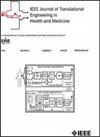Effective Tumor Annotation for Automated Diagnosis of Liver Cancer
IF 4.4
3区 医学
Q2 ENGINEERING, BIOMEDICAL
IEEE Journal of Translational Engineering in Health and Medicine-Jtehm
Pub Date : 2025-06-05
DOI:10.1109/JTEHM.2025.3576827
引用次数: 0
Abstract
In recent years, visual cancer information retrieval using Artificial Intelligence has been shown to be effective in diagnosis and treatment. Especially for a modern liver-cancer diagnosis system, the automated tumor annotation plays a crucial role. So-called tumor annotation refers to tagging the tumor in Biomedical images by computer vision technologies such as Deep Learning. After annotation, the tumor information such as tumor location, tumor size and tumor characteristics can be output into a clinical report. To this end, this paper proposes an effective approach that includes tumor segmentation, tumor location, tumor measuring, and tumor recognition to achieve high-quality tumor annotation, thereby assisting radiologists in efficiently making accurate diagnosis reports. For tumor segmentation, a Multi-Residual Attention Unet is proposed to alleviate problems of vanishing gradient and information diversity. For tumor location, an effective Multi-SeResUnet is proposed to partition the liver into 8 couinaud segments. Based on the partitioned segments, the tumor is located accurately. For tumor recognition, an effective multi-labeling classifier is used to recognize the tumor characteristics by the visual tumor features. For tumor measuring, a regression model is proposed to measure the tumor size. To reveal the effectiveness of individual methods, each method was evaluated on real datasets. The experimental results reveal that the proposed methods are more promising than the state-of-the-art methods in tumor segmentation, tumor measuring, tumor localization and tumor recognition. Specifically, the average tumor size error and the annotation accuracy are 0.432 cm and 91.6%, respectively, which suggest potential for reducing radiologists’ workload. In summary, this paper proposes an effective tumor annotation for an automated diagnosis support system. Clinical and Translational Impact Statement—The proposed methods have been evaluated and shown to significantly improve the efficiency and accuracy of liver tumor annotation, reducing the time required for radiologists to complete reports on tumor segmentation, liver partition, tumor measuring and tumor recognition. By integrating into existing clinical decision support systems, it has the potential to reduce diagnostic errors and treatment delays, thereby improving patient outcomes and clinical workflow.肝癌自动诊断的有效肿瘤标注
近年来,利用人工智能进行视觉肿瘤信息检索在诊断和治疗方面已被证明是有效的。特别是在现代肝癌诊断系统中,肿瘤的自动标注起着至关重要的作用。所谓肿瘤标注,是指利用深度学习等计算机视觉技术对生物医学图像中的肿瘤进行标注。经过标注后,肿瘤位置、肿瘤大小、肿瘤特征等肿瘤信息可以输出到临床报告中。为此,本文提出了一种包括肿瘤分割、肿瘤定位、肿瘤测量、肿瘤识别在内的实现高质量肿瘤标注的有效方法,从而帮助放射科医师高效准确地做出诊断报告。针对肿瘤分割中存在的梯度消失和信息多样性问题,提出了一种多残差关注网络。对于肿瘤的定位,提出了一种有效的Multi-SeResUnet将肝脏划分为8个不同的节段。根据分割的节段,准确定位肿瘤。在肿瘤识别方面,采用有效的多标记分类器,根据肿瘤的视觉特征对肿瘤特征进行识别。对于肿瘤的测量,提出了一个回归模型来测量肿瘤的大小。为了揭示单个方法的有效性,每种方法都在真实数据集上进行了评估。实验结果表明,该方法在肿瘤分割、肿瘤测量、肿瘤定位和肿瘤识别等方面具有较好的应用前景。具体而言,平均肿瘤大小误差和标注准确率分别为0.432 cm和91.6%,这表明有可能减少放射科医生的工作量。综上所述,本文为自动诊断支持系统提出了一种有效的肿瘤标注方法。临床和转化影响声明-所提出的方法已被评估并显示显着提高了肝脏肿瘤注释的效率和准确性,减少了放射科医生完成肿瘤分割、肝脏划分、肿瘤测量和肿瘤识别报告所需的时间。通过整合到现有的临床决策支持系统中,它有可能减少诊断错误和治疗延误,从而改善患者的治疗结果和临床工作流程。
本文章由计算机程序翻译,如有差异,请以英文原文为准。
求助全文
约1分钟内获得全文
求助全文
来源期刊

IEEE Journal of Translational Engineering in Health and Medicine-Jtehm
Engineering-Biomedical Engineering
CiteScore
7.40
自引率
2.90%
发文量
65
审稿时长
27 weeks
期刊介绍:
The IEEE Journal of Translational Engineering in Health and Medicine is an open access product that bridges the engineering and clinical worlds, focusing on detailed descriptions of advanced technical solutions to a clinical need along with clinical results and healthcare relevance. The journal provides a platform for state-of-the-art technology directions in the interdisciplinary field of biomedical engineering, embracing engineering, life sciences and medicine. A unique aspect of the journal is its ability to foster a collaboration between physicians and engineers for presenting broad and compelling real world technological and engineering solutions that can be implemented in the interest of improving quality of patient care and treatment outcomes, thereby reducing costs and improving efficiency. The journal provides an active forum for clinical research and relevant state-of the-art technology for members of all the IEEE societies that have an interest in biomedical engineering as well as reaching out directly to physicians and the medical community through the American Medical Association (AMA) and other clinical societies. The scope of the journal includes, but is not limited, to topics on: Medical devices, healthcare delivery systems, global healthcare initiatives, and ICT based services; Technological relevance to healthcare cost reduction; Technology affecting healthcare management, decision-making, and policy; Advanced technical work that is applied to solving specific clinical needs.
 求助内容:
求助内容: 应助结果提醒方式:
应助结果提醒方式:


